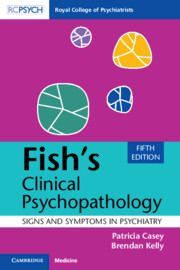Book contents
- Fish’s Clinical Psychopathology
- Fish’s Clinical Psychopathology
- Copyright page
- Contents
- Preface
- 1 Classification of Psychiatric Disorders
- 2 What Is Psychopathology?
- 3 Disorders of Perception
- 4 Disorders of Thought and Speech
- 5 Disorders of Memory
- 6 Disorders of Emotion
- 7 Disorders of the Experience of Self
- 8 Motor Disorders
- 9 Disorders of Consciousness
- 10 Personality Disorders
- Book part
- Index
- References
2 - What Is Psychopathology?
Controversies in Classifying Psychiatric Disorder
Published online by Cambridge University Press: 12 January 2024
- Fish’s Clinical Psychopathology
- Fish’s Clinical Psychopathology
- Copyright page
- Contents
- Preface
- 1 Classification of Psychiatric Disorders
- 2 What Is Psychopathology?
- 3 Disorders of Perception
- 4 Disorders of Thought and Speech
- 5 Disorders of Memory
- 6 Disorders of Emotion
- 7 Disorders of the Experience of Self
- 8 Motor Disorders
- 9 Disorders of Consciousness
- 10 Personality Disorders
- Book part
- Index
- References
Summary
Karl Jaspers, a psychiatrist, theologian and philosopher, is the father of psychopathology. His work General Psychopathology (translated 2013) is a classic in the psychiatric literature. He believed that mental illness, in particular psychosis, should be evaluated with regard to the abnormal phenomena that are present – for example, hallucination, delusions, thought disorder – rather than to their content. The latter (content) was the focus of the psychoanalytic school who argued that content was a clue to underlying traumas and issues that may have contributed to the person’s current state. So whether the content of a delusion was persecutory or guilt-laden, Jaspers believed, was less important than the presence per se of the delusion. Thus, he was distinguishing between form (primary or secondary, systematised or non-systematised, etc.) and content (e.g., persecutory, guilt and nihilistic).
- Type
- Chapter
- Information
- Fish's Clinical PsychopathologySigns and Symptoms in Psychiatry, pp. 11 - 23Publisher: Cambridge University PressPrint publication year: 2024



